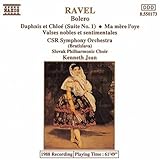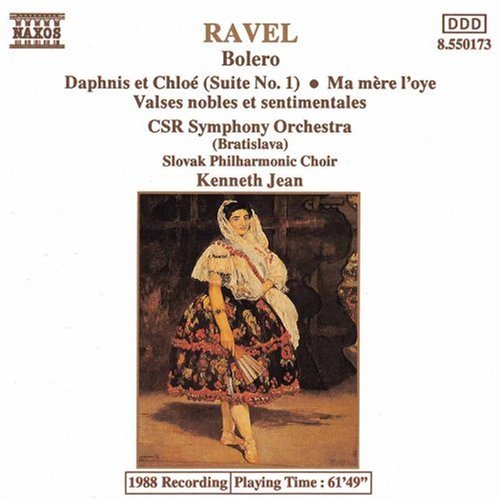Disco de Maurice Ravel: «Ravel: Boléro; Daphnis et Chloé; Ma Mère l'oye; Valses nobles et sentimentales»

- Valoración de usuarios: (2.5 de 5)
- Título:Ravel: Boléro; Daphnis et Chloé; Ma Mère l'oye; Valses nobles et sentimentales
- Fecha de publicación:1992-06-30
- Tipo:Audio CD
- Sello discográfico:Naxos
- UPC:730099517324
- 1Ma mère l'oye: Pavane de la belle au bois dormant
- 2Ma mère l'oye: Petit poucet
- 3Ma mère l'oye: Laideronette, impiratrice des pagodes
- 4Ma mère l'oye: Les entretiens de la belle et de la bete
- 5Ma mère l'oye: Le jardin feerique
- 6Valses Nobles et Sentimentales - Modéré
- 7Valses Nobles et Sentimentales - Assez lent
- 8Valses Nobles et Sentimentales - Modéré
- 9Valses Nobles et Sentimentales - Assez animé
- 10Valses nobles et sentimentales: Presque lent
- 11Valses nobles et sentimentales: Assez vif
- 12Valses Nobles et Sentimentales - Moins vif
- 13Valses nobles et sentimentales: Epilogue
- 14 Boleroimg 6:56
- 15Daphnis et Chloé (Suite 1): Nocturne
- 16Daphnis et Chloé (Suite 1): Interlude
- 17Daphnis et Chloé (Suite 1): Danse guerriere
If, as one might expect, it is Ravel’s ever-popular “Boléro” you are looking for, then I suggest you move on: the Czecho-Slovak Radio Symphony Orchestra directed by Kenneth Jean takes the piece too monotonously. The soft, slow beginning is done quite well, and there is a certain sensuousness to the clarinets, but as the tension mounts and the piece reaches its (in-)famous climax, one has the feeling that Jean is too rigid, too bound to the written notes, too determined to demonstrate Ravel’s simple rhythmic structure and not interested enough in creating genuine excitement, let alone eroticism.
However, this disc contains three other pieces by Ravel, and here I had the feeling that Jean had, on the whole, done a very good job. “La Mère l’Oye” (Mother Goose) was originally a seven-movement piano piece for children, but Ravel himself orchestrated it and turned it into a five-movement orchestral fairy-tale. This (1912) was the age of impressionism in literature, and Ravel breaks through traditional barriers while managing to make his music both tuneful and programmatic. The instrumentation is fascinating, and I have enjoyed listening to “The Conversations of Beauty and the Beast” over and over again. The “Valses nobles et sentimentales” originated about the same time, and here Ravel manages to combine reminiscences of Schubert with a musically ambiguous language that sounds highly modern and could hardly have less in common with Schubert. Finally, there is the first of the two suites from the ballet “Daphnis et Chloë”, a piece demanding a large orchestra and choir ad libitum. Even without the ballet or any information about its action, the music is able to bind me spellbound for its 12 or so minutes duration, and although the Slovak Philharmonic Choir seems to have been recorded without additional microphones, the singers sound, although a little distant, absolutely excellent.
The sound quality of this 1988 production from Bratislava in Slovakia is above-average for early Naxos, although there is a certain amount of hissing in the background reminiscent of re-mastered analogue tapes. And the empty Czechoslovak Radio Concert Hall does cause a certain amount of echoing and harshness on crescendos.
This is the worst Bolero I've ever heard. I could hardly believe this is performed by a professional orchestra! From the very first note (well, beat in fact), the drum is lifeless and boring. Drums are supposed to make this song go forward, no dragging behind. But that was exactly how I felt.
Also, most of the solo are just plainly BAD. They basically sound like some high school students doing it for the first time. I also think they got some jazz saxophone player doing the solo, for they totally ruined the smoothness of this classical composition.
As for other songs in this CD. They are not really much better, the whole orchestra is very dull. But I address heavily on Bolero because I hate to see when someone ruin a classic piece!!!

